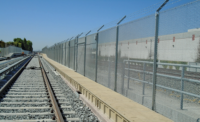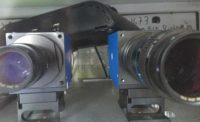In a project aimed at preventing wrong-way driving accidents, Arizona is installing the nation’s first thermal-camera-based, wrong-way-driver detection system along a 15-mile-long stretch of Interstate 17 in Phoenix.
In the $3.7-million project, Mesa, Ariz.-based highway electrical contractor Contractors West is setting poles, running cable and installing more than 40 cameras atop exit ramps and along the side of the roadway in work that is expected to last until the end of November, according to Bruce Farmer, vice president. Installation is to be followed by a period of testing and adjustment.
“We’re dealing with existing conduit systems,” says Farmer. “The challenge is to get new conductors into old systems.”
The project is a result of a 2015 Arizona Dept. of Transportation study of wrong-way driving accidents, says Doug Nintzel, Arizona DOT spokesman.
According to the study, Arizona had 91 wrong-way crash fatalities in 245 accidents between 2004 and 2014. The study identified 39 miles of I-17 in and near Phoenix as the urban highway with the greatest rate of those crashes. It also found that 25% of all wrong-way crashes are fatal, compared to 1% of crashes overall on divided highways. National Highway Traffic Safety Administration analysis of its data shows that, between 2004 and 2014, an average of 350 people died in the U.S. in 270 wrong-way crashes each year.
The ADOT study also found that wrong-way crashes occur most often between midnight and 2 a.m. and that two-thirds are due to driver impairment.
The Maricopa Association of Governments’ Regional Area Road Fund is paying for the project, Nintzel says. Its primary revenue source is a county-wide half-cent sales tax—approved by Maricopa County voters in 2004—for regional transportation projects.
The state conducted a pilot test for the system last year using embedded inductive-loop roadway sensors and concluded that thermal cameras—already in use for traffic-signal operations at several locations—were a better technology to use because of lower cost, greater reliability and fewer “false-positive and false-negative detections,” Nintzel says.
The FLIR-branded TraffiSense cameras provide images and detect motion based on temperature differences between surroundings and objects. The cameras will be connected to the regional freeway system’s fiber-optic network and integrated into a decision-support system, which automatically will trigger illuminated alert signs on exit ramps when a wrong-way entry is detected in an effort to get the driver to self-correct. The system will activate red lights at ramp-meter signals at nearby entrance ramps and block left turns to try to keep other vehicles from entering the freeway. It will post warnings on existing message signs for travelers driving in the correct direction.
The system also will alert the DOT’s Traffic Operations Center and the state’s Dept. of Public Safety, Nintzel says.
Existing closed-circuit cameras will provide visual confirmation, and all of it will be triggered the instant a wrong-way driver is detected.
“Compared to the time it takes to respond to 911 calls from other motorists, the speed of these alerts could save lives,” Nintzel said.





Post a comment to this article
Report Abusive Comment